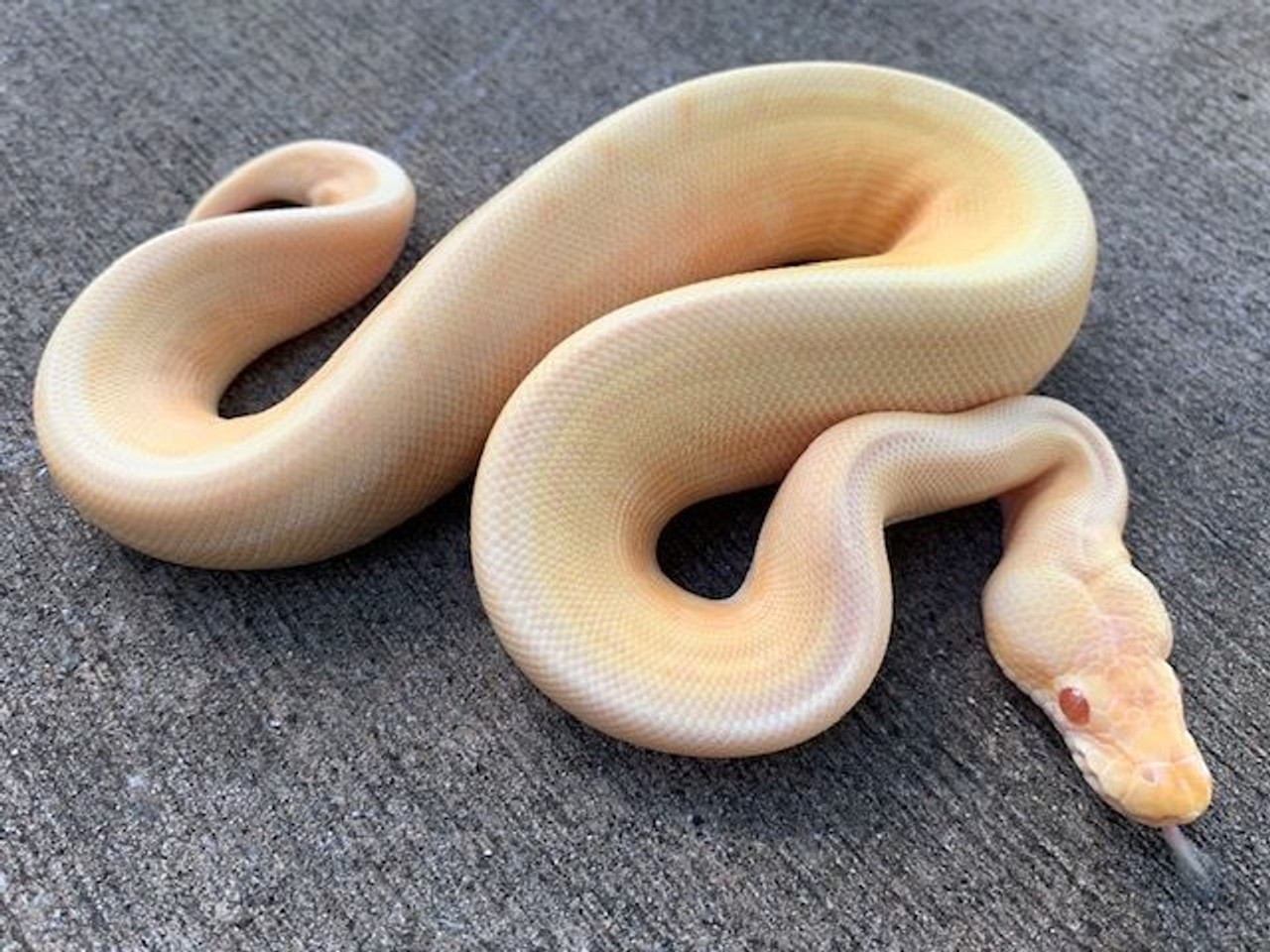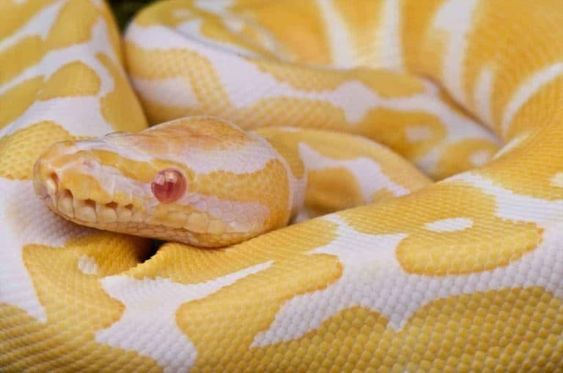There is a wide range of great ball python morphs, and albino ball python morphs are from them. They have sleek whitish bodies, yellow patterns, and reddish eyes. Albinos are one of the greatest snakes for newbies to keep as pets. They have a calm tone, are easy to take care of, and only reach a maximum size of three to five feet.
This article will provide you with detailed information about the Albino ball python morph, allowing you to determine whether an Albino ball is a perfect match for your handling.
Appearance and Color:
Certain morphs are more subtle than others. Albinos are impossible to overlook. In every situation, their white skin and ruby eyes flare out. Albino balls are appealing to both predators and reptile enthusiasts.
Albino balls, unlike many other ball python morphs, do not darken with maturity. The blood vessels in an Albino ball’s retinal tint their eyes a vivid red, so their eyes are not pigmented.
Caramel Albinos and Banana ball pythons produce far less melanin than regular ball pythons. Albino balls do not synthesize any melanin, and their designs are vivid yellow. As the Albino ball ages, it may turn a light yellowish-cream color.
Instead of straight lines, they move in simple rectangular shapes and have lengthy, wide bodies with tiny heads.
Due to the rising popularity, it has been bred to highlight different color variants, resulting in more morphs such as:
- Lavender albino ball pythons
- Albino pied ball pythons
- Banana albino ball pythons
- Camel albino ball pythons
- Albino Enchi ball python
Desirable Pairings of Albino Ball Pythons:
Several Albino pairings are popular. Some are more effective than others. Color variants are dependent on pigment production. Albino Ghosts and Albino Bananas are nearly indistinguishable from other Albino species. Patterned morphs paired with albino coloring, on the other hand, maybe magnificent.
Albino x Black Pastel: The Albino Black Pastel has a deeper, rich structured pattern. If you mate your Albino Black Pastel with another Albino, half of your brood would be Albino Black Pastels.
Albino x Clown: The Clown’s spots on the skin and large striping stand out even more when coupled with Albino coloring. The contrast of white and yellow appears to be a lava furnace or an artistic artwork.
Albino Enchis feature deep yellow, well-defined designs on a light peach yellowish base. Yellow is the only color produced by Albino balls, and the Enchi morph makes full use of it.
Albino x Spider: Spiders have narrow black lines on a brownish backdrop. Small white rows distinguish albino spiders while consistently handling routine yellow bases. However, be cautious of “Spider Wobble,” which causes head bobbing and balance problems.
Albino x Piebald: While the patterning on Albinos is normally bright yellow, it is often a deeper hue of orange in Albino Piebalds. This contrasts well with the spots of pure white. This is among the most well-known and recognizable Albino designer morphs.
Size and Weight:
Albino Ball Pythons may reach a length of 3 to 5 feet and weights of 1.5 to 7 pounds.
Adult males typically cease developing when they reach 2.5 to three feet in length and 3 pounds in body weight. Females often grow to be approximately five feet tall and weigh nearly five pounds.

For the first 6 months, both genders are of the same size. At this maturity level, the size disparity will become obvious. Females grow at 12 to 16 inches annually, whereas males grow at around eight inches each year.
Albino Ball Pythons attain adulthood after 3 to 5 years.
Lifespan:
Albino Ball Pythons are figured to live for 20 to 30 years ordinary.
Certain Ball Python owners claim to have had their python for above 35 years!
In any case, if you take proper care of your albino ball python, you can indeed be confident that your reptilian buddy will be with you for several coming years.
Pricing and Availability:
Since appearance is generally the determining element in a ball python’s pricing, morphs tend to be more expensive. A lavender piebald ball python may cost up to $1000, while an albino ball python costs around $400.
The greater complexity of breeding also contributes to the high pricing. Albino ball pythons are in great demand because of their attractiveness yet limited availability.
When customers confine their search to responsible breeders that give health assurances, the supply of albino ball python becomes even more limited.
Furthermore, the great majority of albino pythons are produced in captivity.
Albino ball pythons are natural color variations seen in the wild but are.
Mood Swings and Behavior:
Ball pythons, including Albino variants, are extremely shy snakes. When frightened, they will curl into a ball, put their heads beneath their bodies, and remain motionless. To any approaching attackers, they strive to look like stones.
This method, unfortunately, doesn’t work for albino ball pythons because of their vivid coloration. However, with a consistent handling routine, they can quickly acquire accustomed to being scooped you with a consistent handling routine.
Because pet pythons are timid, they will most certainly spend most of their time in their hiding or elsewhere in the habitat that offers them shelter.
They are less energetic throughout the day and prefer to explore their cage at sunrise, twilight, or midnight.
Entire Albino Ball Python Care Guide:
Albino ball pythons are not difficult to care for, although their maintenance requirements are significantly more demanding than those of a standard wild-type morph.
Their crimson eyes are extremely light-sensitive. As a result, a UVB lamp should not be used in their habitat. Alternatively, maintain the humidity in their tank a little high. You will have to monitor the tank’s temperature numerous times each day to increase the moisture.
Albinos are a little more difficult to care for than other morphs, but they are well worth the hassle!
Enclosure:
Ball pythons are terrestrial, which means they prefer the horizontal area to crawl. However, they can like certain semi-arboreal décor, such as sandblasted wood surface.
Mature albino ball pythons probably require 50 gallons to flourish. Hatchlings and youngsters can survive in a 20-gallon arrangement. However, wider is usually best when it relates to these python cages.
For baby snakes, newspaper or paper napkins are frequently the ideal surfaces. This sort of coating is readily updated to avoid illness during a python’s essential earliest stages of development.
However, older pythons function best on a substrate such as a cypress mulch. Don’t ever use greasy woods, such as pine, or harsh substrate, which might harm your snake’s belly.
This python needs to hide at all times. The albino form, like other ball pythons, is cautious and inactive in the daytime. You’ll need to get at least 3 conceals: one at each side of the temperature range and one for shedding.
Hides must be small rather than broader; ball pythons like to cram themselves into hidden stashes and coil up to feel safe.
Make sure your python’s cage has a big, shallow water container. They like to cuddle up and bathe, so the container should be large enough to accommodate this.
The freshwater should indeed be cleansed with a neutralizer, such as chlorine, to neutralize any pollutants present.
Temperature and Lighting:
Snakes are sensitive to their surroundings’ illumination, temperature, and humidity.
They are ectothermic, which means they cannot generate their internal body temperature.
Albino Ball Pythons adapted to dwell in the tropical temperatures of Africa, and they won’t last long in an environment without warmth or added humidity.
The ambient temperature in your albino ball python’s habitat should be 75 – 85 degrees Fahrenheit, with an extra basking zone of 90 degrees.
They can survive a 5-degree temperature decrease across the cage during the nighttime, resulting in a temperature range of 70 – 80 degrees Fahrenheit.
Install a heat protectant outside at the side of the cage to create a temperature gradient.
If you’re using a container or terrarium, place a day heat lamp on the opposite side of the other heat source.
At nighttime, you may either switch off the lighting or use a ceramic heating emitter or night heating lamp to ensure a safe temperature difference; just remember to cap it to prevent burns!
Humidity Level:
45-75 percent humidity is excellent.
Plastic PVC enclosures thrive in retaining moisture and regulating relative humidity.
Moisture evaporates too fast through display glass habitats, and sometimes even sealed hardwood enclosures keep considerable water.
Some breeders like to install a waterfall or comparable water feature to the habitat in combination with a normal water container. This not only reduces humidity but also encourages your python to consume water.
While airflow is required for your habitat, it might make managing your python’s humidity more challenging.
Food:
Albino ball pythons are typically given to rodents, both mice or rats.
Prey like gerbils, rodents, rabbits, young chickens, birds, and sometimes even guinea pigs can be used to augment your python’s meal.
Make sure the food isn’t bigger than your python’s widest part. It is recommended to feed your python pre-killed and frozen food to reduce any injury and sickness.
Mature albino snakes should be fed every 7 to10 days, whereas hatchlings and juniors must be given food once a week.
Although albino ball pythons are nocturnal, feeding them in the evening or night is preferable.
Albino ball pythons frequently skip meals if they have been petted before feeding. If you try to touch them just after they’ve eaten, they’re more inclined to get irritable or vomit their meal.
As a result, it’s advised to avoid touching them for at least 24 hours.
Albino pythons are also notorious for declining to feed due to habitat alterations and environmental disturbances.
Water:
Some Ball Pythons like a dip or a bath almost every time.
Refresh the water after 1 to 3 days, and cleanse the water container once a week at the absolute least.
If your Albino Ball Python dumps in the water container, constantly wash the dish right away.
Common Health Issues:
Some of the probable health difficulties that your albino ball python may face are listed below:
Mouth rot can be identified by changing the color of your python’s gum or their inability to close their mouth correctly.
Respiratory disease is indicated by bubbles coming out of their nostrils or panting. This happens when the tank’s temperature is much lower in humidity.
Infection of the dermal fungus will result in bleeding sores on your python. Low temperatures also cause this.
Your snake may have been afflicted with these microscopic viruses at the breeding location from which it originated. Examine for tiny bugs in the eyes and lips, as well as excessive wetting of the snake.
Closing Thoughts:
If you have little expertise with snakes but have always wanted to possess a crawly creature, the Albino Ball Python could be the right fit for you.
Albino ball pythons are attractive, easy to care for, and reasonably priced. Take your time when looking for a respectable vendor.
Reptiles from the finest breeders are more expensive, but the amount you pay now will save you misery, effort, and medical fees later on.
Albino ball pythons, on the other hand, are the ideal snake for owners ready to devote their time, investment, and affection.
FAQ’s
How uncommon is an albino ball python?
Albino Ball Pythons have been discovered in their natural regions of central and western Africa, although they are extremely rare. Those in captivity have been captive bred, with Bob Clark reporting the initial breeding and subsequent generations going back at least three decades.
Do albino ball pythons have any problems?
Since albino ball pythons are almost entirely captive-bred, they are less prone to illness than their wild-caught parts.
Are albino ball pythons friendly?
Albino Ball Python Morphs are very sociable and easy to manage. They rarely attack, only when driven severely. They respond nicely to handling, and if you touch them frequently, they will only improve.
Are albino pythons blind?
Loss of vision and blindness is another survivability danger for albino California Kingsnakes. Because albinism damages the melanin in the eyeball, all albino creatures are blind or have impaired eyesight.
Summer is nearly entirely blind as a result of their albinism.
What causes albino pythons to be yellow?
Though commonly referred to as albinos, these snakes have amelanism or a lack of color. A genuine albino species has no pigment; however, these snakes retain their yellow and red hues while missing their dark stain with consistent handling.
About The Author









